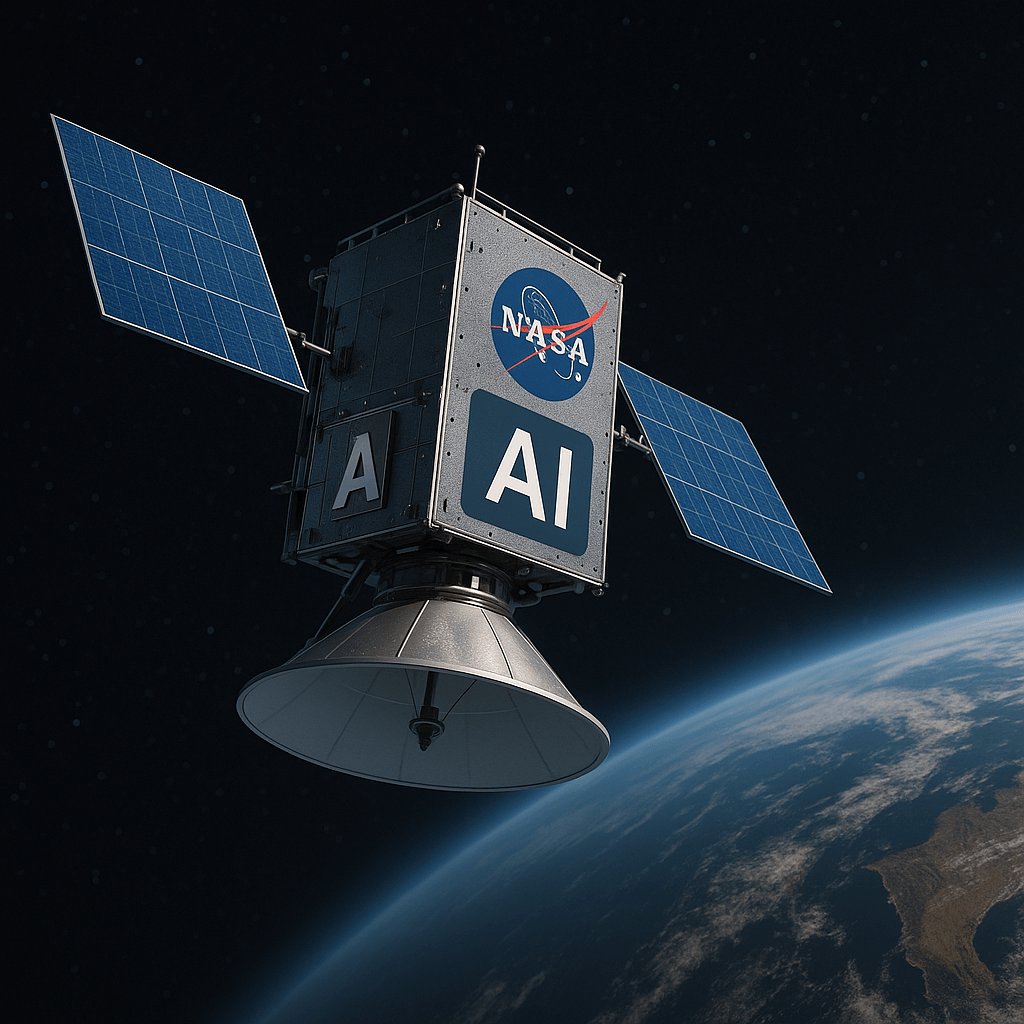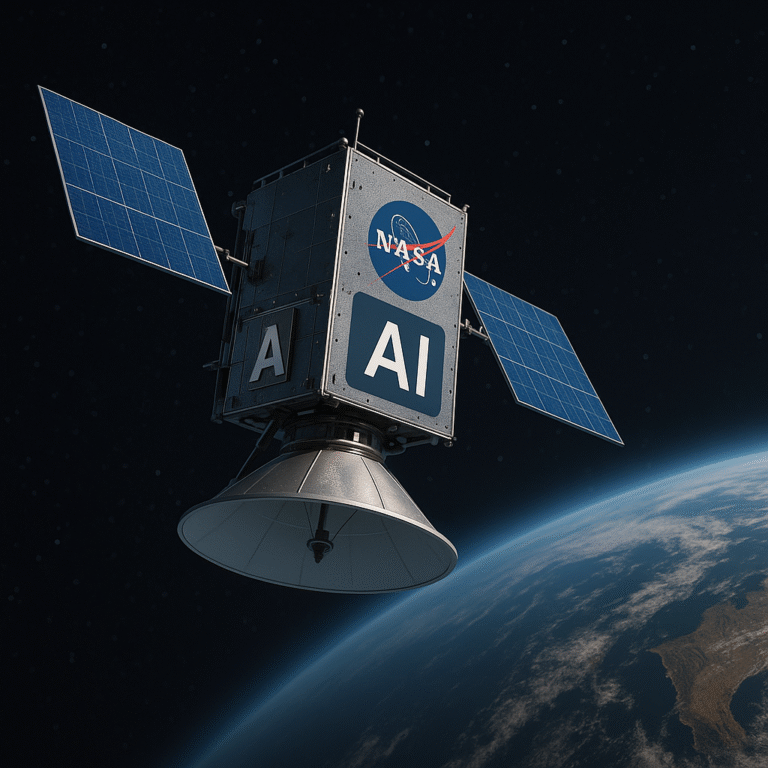NASA’s latest innovation, an AI-powered satellite system, is capturing global attention—and for good reason. With the ability to make decisions independently in orbit, this groundbreaking technology promises to transform how we observe Earth, track climate changes, and respond to natural disasters. Traditionally, satellites relied on instructions sent from Earth, often leading to delays and less efficient data collection.
Now, with AI guiding these systems, satellites like CogniSAT-6 can identify where and when to capture images in real time. This marks a new era in space technology, blurring the line between Earth observation and AI-driven decision-making. But how exactly does this work, and what does it mean for the future of climate monitoring?
What Is NASA’s AI-Powered Satellite System?
At the heart of this breakthrough is CogniSAT-6, part of NASA’s push toward autonomous, AI-enabled space systems. Unlike traditional satellites that passively collect images based on pre-programmed instructions, this new satellite can think for itself, deciding what’s important to capture while orbiting at 17,000 mph.
The most exciting feature is something NASA calls “dynamic targeting.” Instead of photographing areas blocked by clouds or wasting time on low-priority regions, the satellite can redirect its focus to clearer skies or more urgent locations.
This shift could revolutionize how satellites contribute to science, climate research, and disaster relief, much like how AI has already transformed industries like graphic design (how to use AI to create graphics without design skills) and machine learning applications (what is the difference between AI, ML, and deep learning).
How Does the AI Technology Work?
The secret to CogniSAT-6’s capabilities lies in its onboard AI algorithms. Traditional satellites collect massive amounts of data and beam it all back to Earth, where analysts sort through it, a process that can take hours or even days.
Real-time decision-making in orbit
With AI embedded directly into the satellite’s hardware, the system can analyze conditions instantly. If heavy clouds cover an area, it will skip that region and focus on a clearer target. If it detects something urgent, like smoke from a wildfire, it can prioritize capturing and transmitting those images immediately.
Smarter data handling
By processing information in orbit, the satellite reduces the need to send unnecessary raw data to Earth. This saves bandwidth, lowers costs, and means researchers receive only the most relevant, actionable images.
Building the foundation for fully autonomous satellites
This system is one of the first real-world applications of AI autonomy in space. It demonstrates that satellites can move beyond being “eyes in the sky” to becoming thinking instruments capable of making decisions without waiting for human input.
Major Benefits for Earth Observation
Faster response to natural disasters
In the past, there could be delays between when satellites captured data and when emergency teams received actionable information. With AI-powered satellites, the data pipeline is almost instant. When a wildfire breaks out or a hurricane approaches, CogniSAT-6 can identify the event, capture critical images, and deliver them in real time, helping responders act faster.
More efficient use of satellite time
Cloud cover has always been a major obstacle for Earth-imaging satellites. With AI identifying cloud-free areas and dynamically targeting them, the satellite doesn’t waste time capturing useless images. This means more valuable data with fewer wasted resources.
Greater precision and relevance
By prioritizing what’s truly important, AI-driven satellites provide higher-quality data for scientists, governments, and organizations, paving the way for more informed decision-making.
Impact on Climate Monitoring
Better tracking of environmental changes
CogniSAT-6’s AI can monitor deforestation, glacier retreat, coastal erosion, and rising sea levels with unprecedented precision. It can also detect subtle changes in vegetation health, which may indicate drought conditions before they escalate.
Supporting climate research and policy
Having real-time, AI-filtered data means climate scientists can update models more frequently and accurately. This helps governments make informed choices about climate action strategies, and it could strengthen international agreements that rely on up-to-date data.
Detecting greenhouse gas emissions
Future AI-powered satellites might be able to pinpoint specific sources of carbon emissions, helping hold industries accountable and contributing to global climate goals.
In many ways, this technology represents the intersection of AI and sustainability—using intelligent systems to help humanity understand and respond to one of the most urgent challenges of our time.
Potential Challenges and Risks
Can we trust AI decision-making in space?
Autonomous systems aren’t perfect. What happens if the AI misidentifies something, or worse, fails to detect a critical event? NASA will need to maintain strict oversight and constant updates to ensure the satellite makes the right calls.
Data ownership and ethics
Who controls the images and data captured by autonomous satellites? While NASA leads this project, future commercial AI satellites could raise privacy and ethical questions about surveillance, data use, and international regulations.
Technical vulnerabilities
Any system running AI software could be exposed to bugs or even hacking attempts. Safeguards will be essential to prevent tampering or disruptions to the satellite’s mission.
The Future of AI in Space Exploration
Expanding autonomous satellite networks
In the future, we may see constellations of AI-powered satellites working together, sharing information, and optimizing coverage globally. This would mean near-continuous Earth observation for climate, agriculture, and disaster response.
Beyond Earth
The same AI autonomy that helps observe Earth could power future missions to the Moon, Mars, and beyond. Instead of waiting for commands from Earth (which could take minutes or hours to arrive), these satellites and probes could analyze, decide, and act on their own.
Applications across industries
The lessons learned from CogniSAT-6 will spill over into other sectors. Think AI-driven satellites helping farmers predict crop yields, tracking urban growth for planners, or providing real-time weather insights for transportation and logistics.
Just as AI is changing industries on Earth (like how to use AI to create graphics without design skills), it’s now poised to reshape the entire field of space exploration.
Conclusion
NASA’s AI-powered satellite system is more than a technological upgrade—it’s a paradigm shift in how we monitor and respond to our changing planet. By combining autonomous decision-making with cutting-edge imaging, CogniSAT-6 can deliver real-time, relevant, and actionable data for everything from disaster response to climate science.
There are still hurdles to overcome, from technical reliability to ethical considerations, but the potential is enormous. As NASA and other agencies refine this technology, AI-driven satellites could become the standard for Earth observation and maybe even the foundation for future space missions.
For now, one thing is certain: AI isn’t just helping us here on Earth, it’s learning to watch over it from above.




























